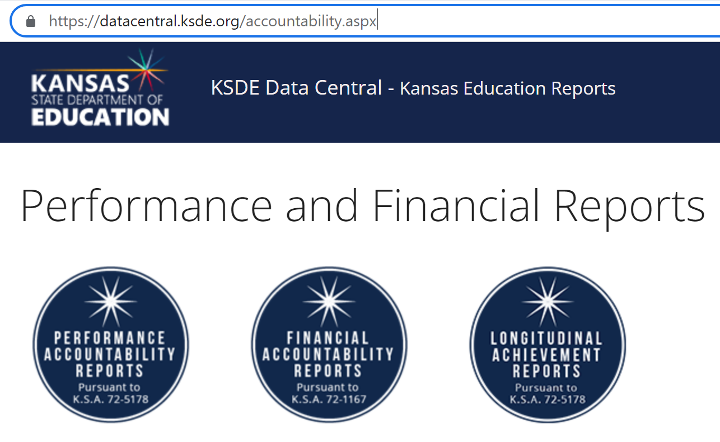PERFORMANCE AND FINANCIAL REPORTS

How well are we doing? That’s a question we receive often as we develop budgets, negotiate with teachers and make decisions about staff and budgets.
“Grading” a student usually means looking at multiple areas, and the same is true of schools. There is a wealth of information on school district performance. A good summary is the state accountability report, which can be accessed through this link on the Kansas State Department of Education website.
This link displays three portals as seen above.
The first link opens to a two-page accountability report. The second link directs visitors to budget information for each district. The third button leads to detailed reports on state academic assessments for each district and school building.
Here are the key measures in these accountability reports and some issues to consider. These are the indicators the State Board of Education is using in the new state accreditation system, based on its “Kansans Can” outcomes. Kansans Can is the State Board’s plan to lead the world in the success of each student based on several outcomes; a focus on preparing students to be successful adults academically, individually and interpersonally; through outcomes-focused accreditation, redesigning schools to be more student-centered and other initiatives.
Academically Prepared for Postsecondary Success
What percentage of students scored at Levels 3 and 4 on the state assessments?
Levels 3 and 4 are higher than traditional “grade level” or “proficient” standards. They are based on having students fully prepared for four-year college degrees. (Data show that many students who score in Level 2 or lower may also go on to postsecondary success.)
Compared to national tests, a study found Kansas state assessments had the highest standard benchmark in the nation. Scoring at this level is more rigorous than scoring “college-ready” on the ACT test.
The goal is to move from approximately one-third of students at this level to 75 percent, based on projected future employment needs. Currently, only about one-third of Kansas adults have four-year degrees or higher.
How are the percentages changing over time? (Trends are shown on the second page of the accountability report or by using the Longitudinal Achievement Report portal.)
Most school districts have seen a decline in students at higher levels since the current state assessments were adopted in 2015. Three reasons are often cited: reduced state funding for staff and programs before the state began a six-year phase-in of increased funding in 2018; more “high need” students struggling with mental health and other issues; and the impact of COVID-19. (Private school systems also had a decline in test results).
Under new state law, school boards are required to review state assessment results as part of the district budgeting process and estimate the time it will take to get all students to levels 3 and 4.
How do different student groups do on state assessments?
The second page of the accountability report shows state assessment results over three years for all students, low income (free and reduced-price meal eligible) students, students with disabilities and the largest minority groups (African American and Hispanic). In most districts, there are significant differences among these groups, influenced by factors outside of the school.
What percentage of students take the ACT test and how are results changing?
The second page of the accountability report shows the district’s composite score on the ACT test compared to the state average. It’s important to also consider how many students take the test, which indicates an interest in postsecondary attendance, how many students are scoring at “college-ready” and how those results are changing.
Graduation Rate and Postsecondary Effective Rate
What percentage of students have demonstrated effective preparation for postsecondary studies, from technical college to two- and four-year college?
To be counted, a student must have graduated from high school and met one of the four following outcomes within two years of high school graduation: (1) earned an industry-recognized certification while in high school, (2) earned a postsecondary certificate, (3) earned a postsecondary degree, or (4) continued to be enrolled in a postsecondary program in both the first and second year following High School graduation.
While state assessments are one measure of student readiness for college, this measure shows how many students actually achieve postsecondary success. In fact, a higher percentage of students statewide complete postsecondary credentials than score at Levels 3 and 4 on state assessments.
How does your district compare to its “predicted” rate of success?
Each district has a predicted rate of success based on districts with similar student demographics such as poverty and chronic absenteeism. This allows a comparison of success among districts with comparable challenges.
Is the graduation rate and postsecondary effective rate improving?
Many districts had more students graduating and improving on postsecondary rates until the COVID pandemic disrupted postsecondary programs through school closures, online learning and other factors.
Other State Board goals (Kansasns Can Star Recognition Program)
What is the district doing to improve social-emotional learning, kindergarten readiness, individual plans of study and civic engagement?
These four goals do not have a numeric calculation, but have received strong support from educators, parents, community members and business leaders as important to student success. The State Board recognizes high-quality programs in these areas, but districts must apply for the recognition.
Graduation, Attendance, Chronic Absenteeism and Drop-Out Rates
What percentage of students are regularly attending and staying in school through graduation?
The accountability report shows how each district compares with the state average. These measures were also affected by the COVID pandemic in many districts.
What is USD 231 doing to improve results?
Most people understand the COVID pandemic has affected almost every part of society and that students today face additional challenges to learning. The Kansas Constitution calls for ongoing educational improvement, so just as important as the current status of a school system is what the district is doing to improve results. How is the district using data to make decisions? What programs and strategies are being implemented or changed? How is the district using state and federal funding to address student needs?
Conclusion
The accountability reports on the KSDE website contain a wealth of information on each and every school district in the state. The information is provided to give parents, teachers, administrators and education policymakers a look into how districts are doing in order to formulate strategies to improve.
